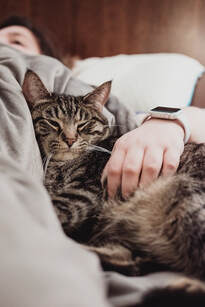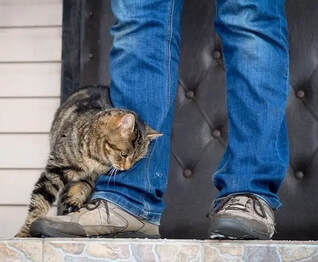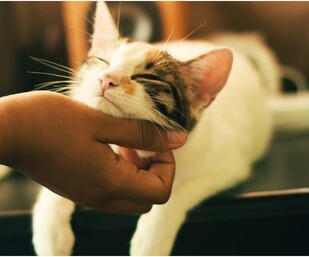 If you plan to put a costume on your pet, make sure it follows these guidelines:
Email: [email protected] Phone: 970-218-2356 Website: hugalovepetsitting.com
0 Comments
 It is not fun when your four-legged loved one is not feeling well. Some things to help if they are vomiting is doing a process of elimination. Photo by Chris Abney on Unsplash Most definitely try to look at pet surroundings and re-collect if can see or remember anything that your cat may have gotten into. Making sure cat is not showing any signs of distress as well. Providing a calm and stress-free environment. As we know stress can trigger physical and emotions within our bodies, same for animals. Double check pet home to look to see if possibly they ate something they should have not. Hair balls are common in cats. Is your cat just trying to eliminate a hair ball? Some common hairball symptoms include hacking and gagging. Usually, your cat will vomit the hair ball in relatively short order. Getting to know your cat and having good relationship with your veterinarian will help. Some cats are more prone to hair balls, In which it is just a matter of changing their diet, adding fiber and staying up on their grooming. It is very important to know if what your cat is experiencing is normal or not. After eliminating that the pet environment seems safe and normal and there are no possibilities of a hairball, you can start looking into their digestion. Is this a possible stomach virus? Change in new food? Allergies? In this process, do not force food or meals. It is okay if your pet is not wanting to accept food for the time being. Just as sometimes us humans get stomach bugs or viruses, we do not want to eat, nothing sounds good, we just do not feel hungry we are afraid to eat as it will just come back up. Your body and your pet’s body are pretty amazing. We as humans can get to know our body and listen to its needs and wants, as well as doing our best to know our pets needs and wants. Staying hydrated is the key though so make sure the pet has access to water. It is okay for them to skip a meal. Keep monitoring your cat. If you cat does eat, is it vomiting still and not able to keep food down? Or try offering a small portion of bland food. Such as boiled skinned chicken. If cat tolerates this, you can give a little more after a few hours. As this point it is to not scarf it down and throw it back up, but to let it settle and eat a little bit here and there in moderation. Offering small and frequent meals. If cat is still vomiting very frequently, best to contact your veterinarian. But if your cat is drinking and eating a little bit, acting like it is not in distress, maybe rest more and use your discretion for what is best for your cat. Email: [email protected] Phone: 970-218-2356 Website: hugalovepetsitting.com If your dog has arthritis, there are several ways you can help them feel more comfortable10/16/2023  1. Consult your vet for effective treatments Arthritis can be treated with anti-inflammatory medication and dietary supplements. Your vet may prescribe non-steroidal anti-inflammatory drugs to decrease inflammation and pain. 2. Control weight and diet Joints with arthritis deteriorate more quickly in overweight dogs. Losing weight takes some strain off your dog’s bones and joints. Special diets that contain omega-3 fatty acids, glucosamine, and chondroitin sulfate can also help relieve arthritic symptoms. 3. Offer a soft bed An orthopedic dog bed made from memory foam will help support your dog’s joints and bones. Providing a supportive bed is also very important for thin dogs, whose bones might otherwise rub uncomfortably on hard surfaces. Some pet stores sell beds made especially for dogs with arthritis. 4. Install ramps, cubes, and slip-free flooring Senior dogs can have a hard time navigating stairs, hardwood and tile floors. Ramps and cubes are available to help your dog climb stairs and get up or down from sofas. Placing rugs or carpets over slippery floors will make your dog much steadier on their legs. 5. Try massage and exercise Think of all the times your faithful friend has helped you feel better. Now is an excellent time to repay the favor. Massage can increase your dog’s mobility and flexibility, improve circulation, and help them relax. You can gently knead your dog’s stiff muscles (avoid putting direct pressure on your dog’s joints, which could be painful), or schedule an appointment with a professional pet massage therapist who can pamper your dog. Even with arthritis, daily exercise helps strengthen your dog’s muscles and ligaments and reduces the risk of injury. 6. Make time for grooming Arthritic dogs can not clean themselves as well, especially in those hard-to-reach areas. For this reason, a senior dog should be even more groomed often than a younger one. Brush your dog’s hair regularly to get rid of matting and -tangles, and remember to be always gentle. Email: [email protected] Website: hugalovepetsitting.com Phone: 970-218-2356
Dogs age more quickly than humans. It used to be that one human year was equal to seven “dog years”. But recent studies have shown that this isn’t exactly true. Multiplying your dog’s age by seven may be easy to do, but it won’t accurately convert dog years to human years. Science states that the first year of a dog’s life is equivalent to a human's first 12-15. The second year of a dog’s life equals about 9-10 human years, while each year after that is worth about 4-5 human years. So, a year in dog years could equal anywhere from 4-15 human years, depending on which life stage your dog is in and their size. The dog life stages are the puppy, adolescent or teenage, adult, and senior stages. Size of dogs: small (up to 20 lbs), Medium (21-50 lbs), large (51-100 lbs) x-large (over 100 lbs) This is the opposite in the animal kingdom where larger animals usually outlive smaller ones. Smaller dogs are usually considered seniors at the age of 7, while large breed dogs might be considered seniors at age 5 or 6. Other researchers show that because large-breed dogs age faster, they also develop age-related diseases earlier in their lives. Another theory is that small dogs might tend to be “pampered”—carried around in purses or kept inside, for example—while large dogs tend to lead a more active lifestyle. A more active lifestyle comes with risks which could lead to earlier mortality. There is a chart, if go to www.petmd.com that will give you a basic idea of what life stage your dog is in and how old your dog is in human years. Please note that these are not exact guidelines.
Email: [email protected] Phone: 970-218-2356 Website: www.hugalovepetsitting.co |
|








